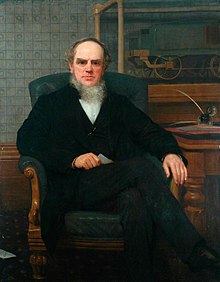John Ramsbottom (engineer)
| John Ramsbottom | |
|---|---|

1879 by William Percy (1820–1893), with a model of his water scoop
|
|
| Born | 11 September 1814 Todmorden |
| Died | 20 May 1897 (aged 82) |
| Nationality | British |
| Engineering career | |
| Discipline | Mechanical engineering |
John Ramsbottom (11 September 1814 – 20 May 1897) was an English mechanical engineer. Born in Todmorden, then on the county border of Yorkshire and Lancashire. Ramsbottom was the son of a steam cotton mill owner. He learned about steam engines, rebuilding his father's and also invented the weft fork (this has also been attributed to James Bullough) that enabled looms to be run at high speed. He also created many inventions for railways.
In 1839 Ramsbottom joined Sharp, Roberts and Company of Manchester who made both industrial stationary engines and steam locomotives, and learned of the latter. He was recommended by Charles Beyer in 1842 to become locomotive superintendent of the Manchester and Birmingham Railway (M&BR). In 1846 the M&BR merged and became the London and North Western Railway (LNWR), and Ramsbottom became District Superintendent North Eastern Division. In 1857 Ramsbottom became locomotive superintendent of the Northern Division (lines north of Rugby), based at Crewe. He is credited with designing and introducing the first water troughs to be used by locomotives to pick up at speed.
In 1852 he invented the split piston ring, which provided a tight seal of the piston against the cylinder with low friction. His other inventions included the Ramsbottom safety valve, the displacement lubricator, and the water trough.
...
Wikipedia
